Back to search results
Name: RUCK, Roger Edwin George
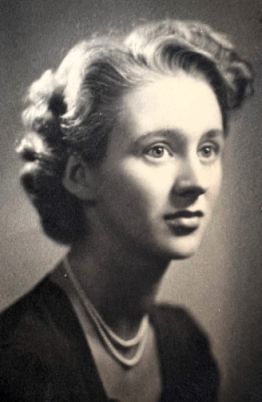
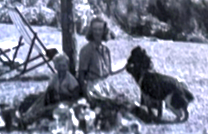
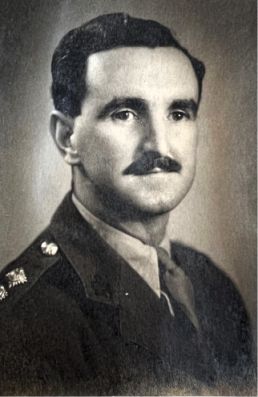
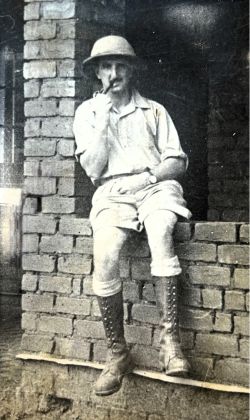
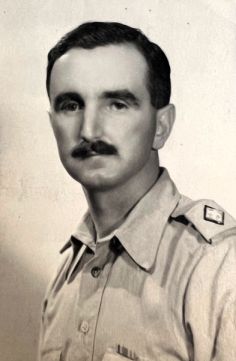
Photo Source: Roger Ruck (nephew)
Birth Date: 1912 Taunton, bapt. 14 July
Death Date: 24 Jan 1953 Kinangop, killed by Mau Mau
Last Date: 1953
Profession: Farmer
Area: North Kinangop
Married: Dr Esmée Adeline De Smidt b. 1920 Chesterton, Cambs., d. 24 Jan 1953 north Kinangop (dau. of Frank Philip Gilbert De Smidt) (prev m. in Pinetown, S. Africa in 1921 John Burnham King b. 1921)
Children: Michael, 6 yr. old son murdered by Mau Mau 24 Jan 1953
Book Reference: Best, Campbell, Precarious, Verandah, Ione, Frampton, Hut, KGF, Nicholls, Barnes
General Information:
Best - A family named Ruck was wiped out on the Kinangop in particularly appalling circumstances. Mbogo the syce and Gitahi the tractor driver lured 38 year old Roger Ruck out of his house on a pretext and then butchered him in the darkness. Esme, his young doctor wife, suffered the same fate when she ran to his aid. After hacking the two bodies to shreds, and that of a Kikuyu gardener who tried to intervene, the gang stormed into the drawing room in search of firearms and money. Half crazed with bloodlust, Gitahi began to hammer the keys of the piano while Mbogo and the others trooped upstairs and chopped through a locked door to get at 6 year-old Michael Ruck, cowering shrunkenly underneath his bed.
Jack the Ripper had nothing on the way the gang left Michael that night. Perhaps it was the killing of the child, perhaps it was the knowledge that Esme Ruck had devoted her life to running a medical clinic for the local African population, but something about the Ruck atrocity woke up Kenya's settler population to the fact that Mau Mau was not simply a piece of lunacy that happened only to other people.
The Rucks were the very last people to invite such an attack. Plain, honest, hard-working folk, they represented everything that was good in Kenya Europeans. They were fond of their African servants and inspired affection in return.
Campbell - Roger Ruck. He was a farmer and a neighbour of Bowyer. "Bowyer was slashed to bits," said Roger Ruck, who had a black stubble of beard, and whose lips were pale. "All the fingers of one hand were gone. After they killed him they disembowelled him. When we tried to lift the body out of the bath, bits of his bowels began to slide down the drain." His face worked. "Bloody Kukes". Ruck told us there were about 20 farmers with their wives and children living on the plateau. ..…..
Mrs Ruck drove up. She was a pretty, fair-haired girl, with a lovely complexion. Ruck introduced us to his wife. "She's been nursing Kukes," he said bitterly. "She's a qualified doctor. She looks after their children, and hands out medicines to the sick." "Not any more," said Mrs Ruck. "After Bowyer, I'd rather tend animals." ..... "I'll tell you one thing." Ruck said, "and you can print it. These bastards won't get me the way they got Bowyer. From now on, so far as I'm concerned a dead Kuke is a safe Kuke." He repeated: "They'll never get me." ........... Weeks later, when I was back in Johannesburg, I read that the Mau Mau had killed not only Ruck, but his wife and child as well. One night a servant of the Ruck's knocked on the farmhouse door. He told Roger that a Mau Mau oath taker was hiding in one of the huts on the farm. Roger got his gun and went out. It was a trap, and he was slashed to pieces on his lawn, before he could fire a shot. Mrs Ruck ran to her husband's aid and was also murdered. The killers then entered the farmhouse, where the Ruck's child lay asleep. They broke down the door of the room and cut the child's throat.
Precarious - Roger Ruck, 38 and his wife Esme, a doctor. A very popular pair, they lived about 4 miles from where Bowyer was done to death, but 2 miles from the forest edge and were well alive to their danger. .….
Verandah - Esme was a childhood friend of Suzanne Fisher neé Allen - Esme and I continued friends till long after I left Limuru to go to England. After she trained as a doctor she came back to Kenya, married and lived on a farm where she ran a dispensary for the Africans for miles around. She and her husband and small son were brutally murdered by their own houseboys during Mau Mau.
Ione - Roger Ruck and his wife lived on a farm on the Kinangop, an area which had already been the scene of 2 Mau Mau murders; their home was near the farm where Eric Bowyer had been killed and not far distant from Thomson's Falls where 3 weeks earlier, Charles Fergusson and Richard Bingley had met their horrible death. The Rucks were not unaware of the dangers which surrounded them ......... they lived in a state of tension, armed night and day. The fact that they had a small child, Michael, who was 6, added considerably to their anxiety. Roger Ruck, tall and athletic, hunted, played a good game of polo, and had a reputation as an oarsman. His wife, who was Kenya born, had qualified as a doctor in S. Africa. She treated the natives free of charge for miles around. They had been living with a neighbour for some time, so that Ruck could perform his KPR duties at night knowing that his wife and child were not on the farm alone, but a few days before Christmas they returned to their home for the harvesting. Before she left her neighbour's house, Mrs Ruck said: "If anybody attacks me, I hope they will leave my son alone." He would have been 7 the following June and was due to go to school ............ Major Reynard's farm ........ Inside the house sat Ruck with his pistol to hand, his wife with a shotgun on her knees. It was their usual routine. At 6 o'clock Michael had had his supper at his own small table beside the fireplace and had been taken up to bed. They had finished their dinner; the servants had gone to their huts, and they were in the house alone. Suddenly they heard the syce outside calling, and Ruck went out on the verandah and asked what he wanted. Mbogo repeated the story that they had concocted about arresting a man on the farm. Ruck asked who the man was, and Mbogo said he did not know, but they had him outside by the lorry. Ruck enquired how many men had caught him, and Mbogo replied that he and the driver alone had caught him.
In spite of all the precautions that he had taken for weeks, Roger Ruck now walked out of the house and into the dark grounds. Near the lorry he stopped and flashed his torch. As he did so Mbogo caught his arms from behind; at the same time 4 men jumped out at him from behind the lorry. A brutal slashing with pangas and simis began. The others who had been hiding behind the fence, came out and joined in the game. ...... Ruck was attacked on all sides. He shouted to warn his wife, and she came running out of the house with her shotgun but before she had time to use it the gang seized her. Ruck, freed for a moment by the onslaught on his wife, tried to get back to the house, but the men caught him again, hammering blows on his head till it was battered to pulp. Mrs Ruck was killed at the same time. They were murdered within sight of each other .....…..
Michael was lying in his cot surrounded by his toys when the men broke open the door and burst in. They battered him to death.
Roger Edwin George - Kenya Regiment 3324
Nicholls - On 24 January 1953 the colony was shocked by the brutal murder of Roger Ruck and his family at their home in north Kinangop; Esmé Ruck died as her unborn child was ripped from her womb. Photographs of the bodies were widely available to settlers.
Nairobi City Park cemetery - Roger E.G. Ruck, died 24 Jan 1953 aged 38, AND Esme Ruck, died 24 Jan 1953 aged 32, AND Michael Ruck, died 24 Jan 1953 aged 6
Frampton - Tom Banks nearly bought the Ruck farm in 1939 - he and Peggy picnicked under the fig tree where the Rucks were killed.
Letter from Constance Prangley to Roger Ruck's sister: I am truly sorry that you should have had to suffer yet a little more and that through a pack of lies published in the Sunday Times. I hope and pray that your dear mother will not have seen this paper. Because you will want to know the truth, I am going to tell you all I know about that cruel cruel massacre. First, Esmée was not pregnant and never had been during her marriage to Roger. The thing they both longed for more than anything else was a child of their marriage. Had there been the faintest hope of pregnancy I know that Esmée would have come to me bursting with joy. Her envy of other women who were having children was sad to see. From what I have written you will draw your own conclusions.
On arrival at Roger’s Farm on that awful morning, the first thing we saw was an African who had been killed. I thought from what I was told at the time, that he was in the treacherous plan to murder the family, I have since heard that he tried to give warning and was killed before he was able to do so. About 15 yards from the African and higher on the slope was Esmée’s body almost decapitated. She was lying stretched out on her back. One wrist was slashed, probably to obtain more quickly her weapon and one ankle also was slashed. She was wearing a long blue housecoat of woollen material. The one thing, which stays in my memory is the way in which her blue slippers were placed beside her body. It looked to me as though in the cold light of day, the syce had been overcome with remorse and had collected her slippers, which would have been lying, one here one there, and placed them together beside her. Lower down the slope was Roger’s body. He was wearing pyjamas and dressing gown. His body was in a sitting position with the head against a tree trunk. The main attack had been directed at his head so mercifully, he would have been unconscious within a second. One ankle with slashed also one wrist but about that I am not dead certain.
At this point the police drove up and I was ordered to return to the car. I first took off my waterproof coat and threw it over Esmée. I did not go into the house but from what I heard from Mr Pape, Michael will have died from the first blow. Had Esmée been further molested I am sure one would have seen traces of the savagery. You will wonder why I had to visit such a scene. The whole reason for doing so was because I expected to find Esmée and Michael alive. The syce had ridden up to me like a bat out of Hell and said “Bwana Roger kwisha kufa”. Then swung round like a madman and was off before I could ask a question. Naturally, my first thought was for Michael and Esmée. I rang Mr Gledhill to say what I had heard and to tell him that I was going immediately by car to the top of the short cut and walking down the forest gorge and so up to the house by the quickest possible route. He begged of me not to do this but to await his arrival and he would drive me over. After a little persuasion I agreed to wait. It is a long tortuous road by car, but time did not count as I was soon to know.
How we miss them, and not least the native! You may know that as an officer of the St John Nursing Division I have done and still do quite a bit of first aid work: mean as it may sound I never miss an opportunity of bringing home to the native the fact that his people have killed one doctor and therefore - - - . All the same I do my best for them.
You will be interested to hear that I am attending an investiture at Government House on 17th March. I am to be decorated with the St John Order for first aid work done in the forest after dark for an African who had a compound fracture of both bones in his leg. The decoration is being given not so much for the first aid rendered as for the fact that it was given under what might have been very dangerous circumstances. Honours sit lightly on me and although I am feeling honoured, I cannot find any enthusiasm in my heart when all around me is so empty. It was last Wednesday only that I wrote to your mother, just to say that she was in my thoughts. It is for her that I grieve most. I lost my eldest son in the war, so I know something of her suffering.
Dear Roger always referred to you as his favourite sister and Esmeé and I used to talk of you often because Roger made us wish to meet you. Dear, dear Roger, so full of fun and such a good sort. I used to admire so much his horsemanship, it was good to see. I think it’s a great pity that the police did not ask friends and neighbuors to take over the charge of Esmée’s and Roger’s personal effects. The police were in charge of the place for weeks after the tragedy. I hear that Mrs Mackie has said that Michael’s trains were on the floor just as he left them when the Makies took over the place. Sounds incredible to me. So far I have not been to the house again although the Mackies have issued many a welcome. Must go one day, but I cannot bear to think of it.
Back to search results





